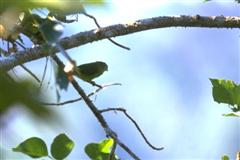Parrotlet - Amazonian
Scientific Name: Nannopsittaca dachilleae
Sat, 12th July, 2025 - 8:23 am GMT
Sponsor Ads:

Alternative Name
Scientific Name: Nannopsittaca dachilleaeBasic Info
The 4.5-inch average length of the Amazonian Parrotlets makes them one of the smallest members of the parrot family known to man. These tiny birds are quite colorful, with their vibrant green plumage and blue crown, forehead and lores. Their throats, cheeks, abdomens, breasts and thighs are a far lighter greenish-yellow. The Amazonian Parrotlet has pink feet.
Health
Amazonian Parrotlets should be kept in an enclosure between 18" and 48" square, for two birds. Breeding Very little is known about the breeding habits of the Amazonian Parrotlet. It is thought that they breed between July and September, during which time they court each other by feeding and preening together. Amazonian Parrotlets usually build their nests in the hollows of large trees.Habitat
N/ABehavior
The Amazonian Parrotlet is very closely related to the larger Amazonian Parrot. Independent pet owners rarely keep them, although their parrot-like attitudes in a smaller package are making them more popular. Found in forests alongside areas with water, the Amazonian Parrotlet is most comfortable in land untouched by human hands. They rarely are found in very densely forested areas, but they often exist where there are bamboo groves. A social bird, the Amazonian Parrotlet usually travels in flocks of between five and 12 birds. They can often be seen perching in groups in trees. As soon as one of the birds calls, the entire flock will fly off, usually to the bamboo grove where they regularly forage for food. Amazonian Parrotlets always have an eye out for their own nutrition: every couple of days, the entire flock will travel to a riverbank rich with minerals and eat the soil there. They also feed on seeds that grow on bushes, trees or bamboo, as well as on wild vines. Although the Amazonian Parrotlet is usually very quiet, they do make calls that sound very similar to the calls of immature chickens. When in a flock, they sound like they are chattering with their squeaking, chirping calls.Origin
PeruHistory
Found primarily in Peru, the Amazonian Parrotlet can be found along Rio Shesha in the Ucayali Province, Rio Manu in Tambopata Reserve, and Madre de Dios Province's Rio Heath. They can also be found along Rio Heath in the La Paz Province of Peru. The Amazonian Parrotlet was unknown to humans until 1985, when they were first seen and recorded by Charles Munn. Their scientific name, Nannopsittaca dachilleae, comes from the name of environmental journalist Barbara D'Achille, who they were named after in 1990. Barbara D'Achille died a sudden and tragic death in the mountains of Peru.Common Foods
N/ASponsor Ads:
Friends don't let friends buy proprietary software
Parrotlet - Amazonian
Coded by: BGID® | ALL RIGHTS RESERVED Copyright © 2000-2025
Disclaimer | Privacy | Report Errors / Contact | Credits
















